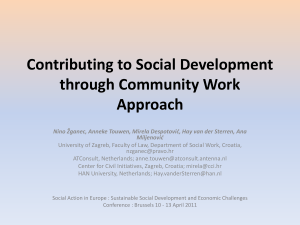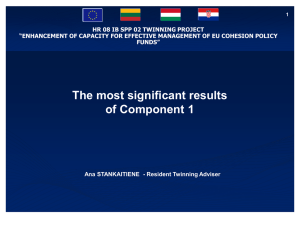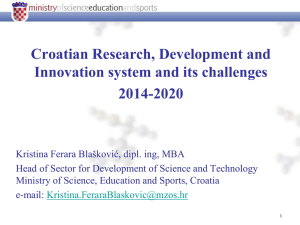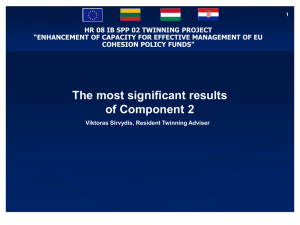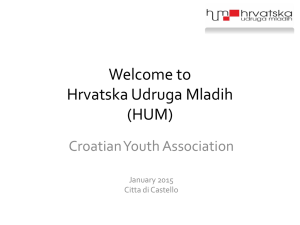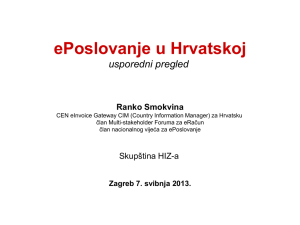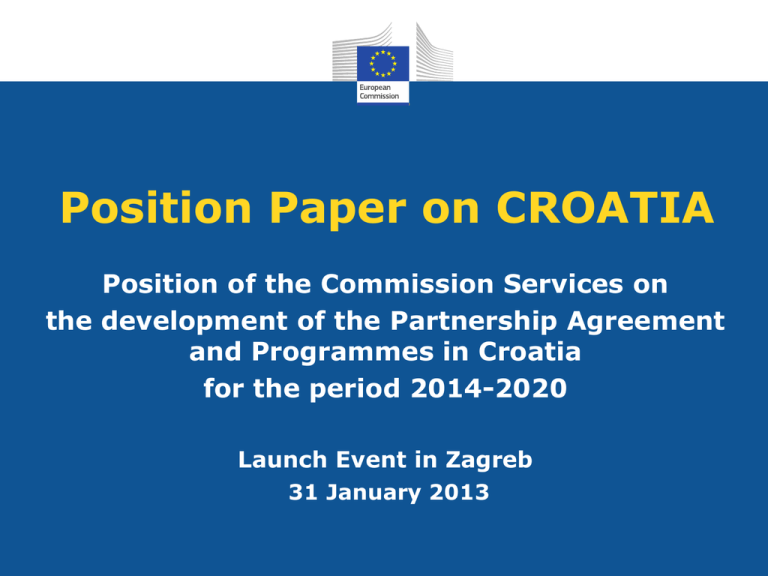
Position Paper on CROATIA
Position of the Commission Services on
the development of the Partnership Agreement
and Programmes in Croatia
for the period 2014-2020
Launch Event in Zagreb
31 January 2013
Introduction
• Strong alignment with the Europe 2020
strategy,
thematic
concentration
and
performance incentives
• Common Strategic Framework covering 5
funds to jointly foster competitiveness,
convergence and cooperation at all levels
• Need for strong prioritisation and result
orientation
2
Commission Services Position Paper
vs.
Partnership Agreement
• Framework for dialogue between Croatia and the
Commission services
• Optimise the use of European Structural and
Investment funds and concentrate future
spending on priority areas
3
Economic situation in Croatia
• Croatian economy has been in recession since 2008
• the level of GDP lowered by more than 10%
• narrow export base and insufficient competitiveness
• unfavourable investment climate
• Unemployment rate close to 15% in 2012
• Efficiency of public expenditure remains a challenge
• Regional disparities exist
• War affected areas
• Remote areas
• Urban-rural divide
4
Europe 2020 headline targets
Europe 2020 headline targets
Current level in Croatia
3% of EU's GDP to be invested in research and development
0.73%
20% greenhouse gas (GHG) emissions reduction compared to 1990
/
20% of energy from renewables
20% increase in energy efficiency
14.6%
/
75% of population aged 20-64 should be employed
57%
Reducing early school leaving to less than 10%
4.1%
At least 40% of 30-34 years old should have completed a tertiary or
equivalent education
Reducing the number of people at risk of poverty or exclusion by 20
mill. in the EU
24.5%
/
…and national targets ??
to be drafted in the economic programme (April 2013)
5
Main challenges
Under-developed
knowledge based
growth factors and
insufficient
infrastructure
Protecting the
environment and natural
resources and adapting to
climate change
Low labour market
participation,
inefficient education
system and a difficult
social situation
Inefficient public
governance
at central/local level and
weak involvement of
partners
6
Challenge: Under-development of
knowledge based factors of growth
and insufficient infrastructure
1. Lagging behind in knowledge based factors of
growth
2. Unfavourable business environment
3. Transport and ICT networks are unbalanced and
hinder competitiveness
7
Source: Eurostat
8
Funding priority:
Strenghtening the competitiveness
of the economy
9
1. Strengthening Croatia's innovation
profile through smart specialisation
• Develop RD&I excellence and promote centres of
competence
• Promote business R&I investment, support
applied research and technological transfer to
help companies develop more innovative
products/ processes/ marketing/ services, and
diversify the national/regional economy through
high-growth activities
10
2. Supporting the modernisation and
competitiveness of enterprises
• Promoting entrepreneurship
• Enhancing the competitiveness of SMEs by
providing high-quality business support
• Facilitating SME's access to finance
• Modernisation of the agricultural, fisheries and
aquaculture sector
! The effective removal of obstacles of business environment and to the
growth of SMEs remains an essential condition for the success of the
interventions supported by the Cohesion policy
11
3. The extension and upgrading of the
transport and ICT infrastructure
• Developing high quality, interoperable railway
system
• Investing in TEN-T network and investing in
regional mobility
• Developing environment-friendly transport systems
and promoting sustainable urban mobility
• Expansion of next generation access broadband
infrastructure & ICT services, particularly in remote
areas
12
Challenge:
Low labour market participation,
particularly of youth, inefficient
education system and a difficult social
situation
13
Employment rate
in 2011, % of total population
Source: Eurostat
14
Employment rate
- young people
in 2011, % of total
population
Employment rate
– women
in 2011, % of total
population
Employment rate
- older people
in 2011, % of
tpotal population
15
Tertiary education attainment
in 2011, 30-34 years old
60.0
50.0
40.0
30.0
20.0
10.0
0.0
Source: Eurostat
16
People at risk of poverty
in 2011, % of the total population
Source: Eurostat
17
Funding priority:
Increasing labour market participation,
ensuring better education and skills
and reducing poverty taking into
account regional differences
18
1. Significantly enhance the labour market
participation of most vulnerable groups, particularly
women, older workers, long term unemployed & youth
2. Increase the employment of young people
• Access to employment for job-seekers and inactive people,
including local employment initiatives and support for labour
mobility
• Sustainable integration of young people not in education,
employment, or training into the labour market
19
3. Improve skills level, address the challenge of
matching labour market skills demand and supply,
improve vocational education and training outcomes
and enhance participation in the educational system
• Improving the quality, efficiency and openness of tertiary
education with a view to increasing participation and
attainment levels
• Enhancing access to lifelong learning, upgrading the skills
and competences of workforce and increasing the labour
market relevance of education and training systems
• Promoting knowledge transfer and innovation in the
agriculture, forestry, maritime and fisheries sectors
20
4. Improve social inclusion of the most vulnerable
groups, including elderly, children, persons with
disabilities and Roma
5. Reduce discrimination
6. Ensure high quality, accessible and decentralised
social and health services and invest in basic
services for the rural population
• Active inclusion
• Combating discrimination based on sex, racial or ethnic
origin, religion or belief, disability, age or sexual orientation
• Enhancing access to affordable, sustainable and highquality services, including health care and social services of
general interest
• Promoting social inclusion, poverty reduction and economic
development of rural, coastal and fisheries area
21
Challenge: Environment, nature
and climate change
1. Waste and water management
•
Meeting EU standards
2. Biodiversity and nature
•
•
High nature value areas/Natura 2000 areas
Agriculture/forests
3. Renewable energy/ Greenhouse gas emissions
•
•
•
•
Meeting target of 20%
Dependance on fossil fuel import
Energy efficiency low
Kyoto targets
4. Climate change adaptation and risk management
•
Risk of droughts, fires and flooding
22
Funding priority: Preserving and
maintaining a healthy environment and
protecting the natural resources and
heritage, and adapting to climate change
23
1. Invest in waste and water sector to meet
the environmental acquis
• Improving the efficiency of solid waste management
• Investing to reach full compliance with the European
urban wastewater treatment directive
• Protecting drinking water resources and ensuring quality
monitoring
• Applying an Integrated Water Management policy
24
2. Protecting biodiversity, improve soil and
water management and promote sustainable
management of Natura 2000 and high nature
values areas, promoting ecosystem services
including NATURA 2000 and green
infrastructures
• Protecting
heritage
• Promoting
• Promoting
other high
• Promoting
and developing the natural and cultural
environmentally sound farming system
sustainable management of Natura 2000 and
nature value areas
sustainable fisheries
25
3. Supporting the shift towards a low-carbon
economy in all sectors
•
•
•
Promoting energy efficiency, the use of renewable energy
and technologies reducing greenhouse gas emissions
Promoting the contribution of forestry to bio-energy
production
Improving the carbon retention capacity of soils and
forests and reducing greenhouse gas emissions from farm
operations
26
4. Promoting climate change adaptation, risk
prevention and management
• Applying
measures
for
climate
adaptation and risk management
change
• Implementation of a national strategy for adaptation to
climate change
• Measures to cope with potential climate disasters
• Creation of early warning systems for floods
• Preventive measures to address specific risks
• Improving drought and water management
• Supporting fire prevention and restoration measures in
forests
27
Challenge: Inefficient public governance at
central and local level; weak involvement
of civil society & social partners
1. Public administration at all levels still not sufficiently
effective, transparent and accountable and the risk
of corruption is still present
2. Involvement of civil society and social partner
organisations in the policy making and in social
dialogue is still limited
28
Funding priority: :
Strengthening the administrative capacity,
enhancing an efficient public administration
and increasing the involvement of civil society
and social partners
29
1. Develop an effective, efficient public administration
• Investment in institutional capacity and in the efficiency of
public administrations and public services with a view to
reforms, better regulation and good governance
2. Strengthen the capacity of social partners and civil
society organisations to be involved in policy-making
and policy-delivery
• Capacity-building for stakeholders, social partners and NGOs
30
European Territorial Cooperation
• Transnational and cross-border approaches
• Croatia should draw up with its neighbours approaches
addressing specific needs (promote sense of partnership)
• EU Strategy for the Danube Region
• coherence between the Strategy and programming of
ESI interventions and exchange of good practices
• devoting sufficient resources and attention to the role of
Priority Area Coordinators and Steering Groups overall
• Maritime Adriatic and Ionian Strategy
• improving coherence, coordination and alignment of
policies and instruments, including country-specific ones,
having an impact on the maritime economy
31
Success factors for effective delivery
structural reforms
human resources
ex-ante conditionalities (e.g. Strategy for smart
specialisation, Active labour market policies, Strategy for
reinforcing administrative efficiency including public
administration reform)
Also…
• mechanism for effective implementation of State Aid law
• existence of appropriate statistical systems and result indicators
• appropriate tendering capacity and procedures in place
32
Negotiation process for Partnership
Agreement
POSITION
PAPER
sent to
Croatia
LAUNCH
EVENT
INFORMAL
DIALOGUE
with Croatia
Croatia sends
PARTNERSHIP
AGREEMENT
through SFC
Negotiation
mandate /
observations
sent to
Croatia
ADOPTION
of
Partnership
Agreement
CPR
adopted
2013
33
Thank you for your attention!
We wish you a lot of success!

